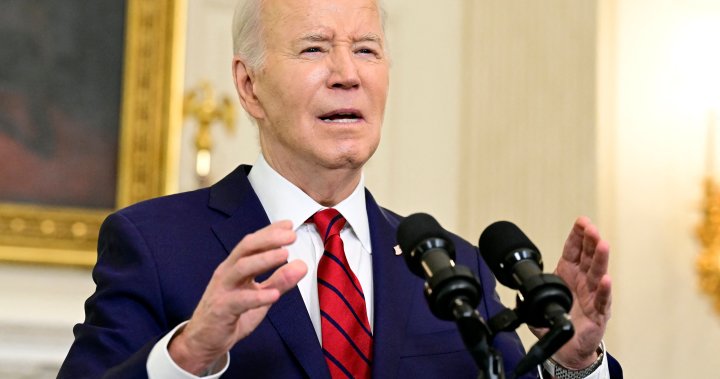The big U.S. aid package for Ukraine and other allies that President Joe Biden signed Wednesday also allows the administration to seize Russian state assets located in the U.S. and use them for the benefit of Kyiv.
That could mean another $5 billion in assistance for Ukraine, coming from Russian Central Bank holdings that have already been frozen in the United States. The seizures would be carried out under provisions of the REPO Act, short for the Rebuilding Economic Prosperity and Opportunity for Ukrainians Act, that were incorporated into the aid bill.
But it’s not likely the U.S. will seize the assets without agreement from other members of the Group of Seven nations and the European Union.
WHAT IS THE DIFFERENCE BETWEEN FREEZING AND SEIZING?
The U.S. and its allies immediately froze $300 billion in Russian foreign holdings at the start of Moscow’s invasion of Ukraine. That money has been sitting untapped — most of it in European Union nations — as the war grinds on. But roughly $5 billion of it is located in the U.S.
The frozen assets are immobilized and can’t be accessed by Moscow — but they still belong to Russia. While governments can generally freeze property without difficulty, turning that property into forfeited assets that can be sold for the benefit of Ukraine requires an extra layer of judicial procedure, including a legal basis and adjudication in a court.
For more than a year, officials from multiple countries have debated the legality of confiscating the money and sending it to Ukraine.

HOW QUICKLY COULD THIS HAPPEN?
Breaking news from Canada and around the world
sent to your email, as it happens.
The new U.S. law requires the president and Treasury Department to start locating Russian assets in the U.S. within 90 days and to report back to Congress within 180 days. A month after that period, the president will be allowed to “seize, confiscate, transfer, or vest” any Russian state sovereign assets, including any interest, within U.S. jurisdictions.
But the U.S. wants to keep consulting with global allies and act together, which is likely to slow down the process.
National security adviser Jake Sullivan said Wednesday the issue would be an important topic when leaders of the G7 countries meet in Italy in June, adding that “the ideal is that we all move together.”
WHAT CAN THE US DO WITH THE MONEY?
Biden is given leeway to determine how the money can be spent for the benefit of Ukraine — but he must confer with other G7 members before acting.
The legislation states that “any effort by the United States to confiscate and repurpose Russian sovereign assets” should be done alongside international allies, including the G7, the 27-member European Union and other nations as part of a coordinated effort.
Policymakers, including Treasury Secretary Janet Yellen, have said the U.S. is not likely to act without the support of G7 allies.
Yellen said after the passage of the bill that “Congress took an important step in that effort with the passage of the REPO Act, and I will continue intensive discussions with our G7 partners in the weeks ahead on a collective path forward,” Yellen said.
WILL EUROPE ALSO SEIZE RUSSIAN ASSETS?
The European Union already has begun to set aside windfall profits generated from frozen Russian central bank assets. The bloc estimates the interest on that money could provide around 3 billion euros ($3.3 billion) each year.
“The Russians will not be very happy. The amount of money, 3 billion per year, is not extraordinary, but it is not negligible,” EU foreign policy chief Josep Borrell told reporters in March.
Still, some European leaders have expressed hesitation about moving forward with a plan to formally seize Russia’s assets in Europe.
European Central Bank President Christine Lagarde said at a Council on Foreign Relations event earlier this month that confiscating Russian assets “is something that needs to be looked at very carefully” and could “start breaking the international legal order.”

WHAT ARE THE RISKS?
Critics of the REPO Act say the weaponization of global finance against Russia could harm the U.S. dollar’s standing as the world’s dominant currency.
To confiscate Russia’s assets could prompt nations like China — one of the biggest holders of U.S. Treasuries — to determine it is not safe to keep their reserves in U.S. dollars.
The conservative Heritage Foundation has criticized Russian asset seizure for, among other things, undermining the dollar-denominated global finance system, saying “it would expose an already fragile economy to unintended consequences and risks for which the United States is unprepared.”
Russian authorities have warned that the new law will undermine the global financial system.
© 2024 The Canadian Press





